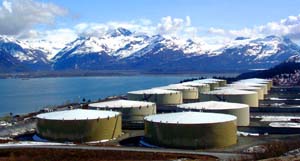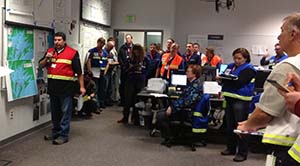A recent council study looked at issues associated with the remote control operations of Alyeska Pipeline Service Company’s Valdez Marine Terminal. Alyeska controls some operations for the terminal and pipeline from its Operational Control Center in Anchorage.
Newsroom
25 years after Exxon Valdez oil spill
How has oil transportation changed in Prince William Sound?
 Although the immediate cause of the spill was a navigational error on the part of the tanker’s captain and crew, complacency among the oil industry, regulatory agencies, and the public was found to play a part in the disaster.
Although the immediate cause of the spill was a navigational error on the part of the tanker’s captain and crew, complacency among the oil industry, regulatory agencies, and the public was found to play a part in the disaster.
Few prevention measures were in place and cleanup resources were inadequate.
Since 1989, regulatory agencies, the industry and citizens have been working together to learn lessons on how we can prevent oil spills and be better prepared to clean up if another spill should occur.
What has improved in oil spill prevention since the Exxon Valdez oil spill?
Double hulls
All tankers transporting oil through Prince William Sound are now double-hulled. Double hulls, basically two steel skins separated by several feet of space, are an effective design feature which can reduce or eliminate spills that result from groundings or collisions.
Real storm plays role in October spill drill
By ROY ROBERTSON
Council Project Manager

Polar Tankers, Inc. conducted the annual Prince William Sound shipper’s drill for 2013 on October 7-9. Polar Tankers is the shipping company owned by ConocoPhillips.
This large drill involved more than 700 participants and included command posts in both Valdez and Anchorage as well as field activities in Prince William Sound.
The scenario had a Polar Tankers ship colliding with two barges being towed in tandem close to Montague Point on Montague Island in Prince William Sound.
New drill features
New guidelines for using dispersants proposed
By STEVE ROTHCHILD
Council Administrative Deputy Director
The Alaska Regional Response Team has proposed new guidelines for how chemical dispersants are approved for use in Alaska’s waters.
This team is an advisory board of resource trustee agencies that provides federal, state, and local governmental agencies with the means to participate in pollution incident response.
The announcement of these new proposed guidelines came in October, and the team held a series of public meetings to discuss the new approval procedures in November in five Southcentral Alaska communities. Council representatives attended three of the five meetings in Kodiak, Anchorage and Valdez. The other two meetings were held out of the council’s geographic area.